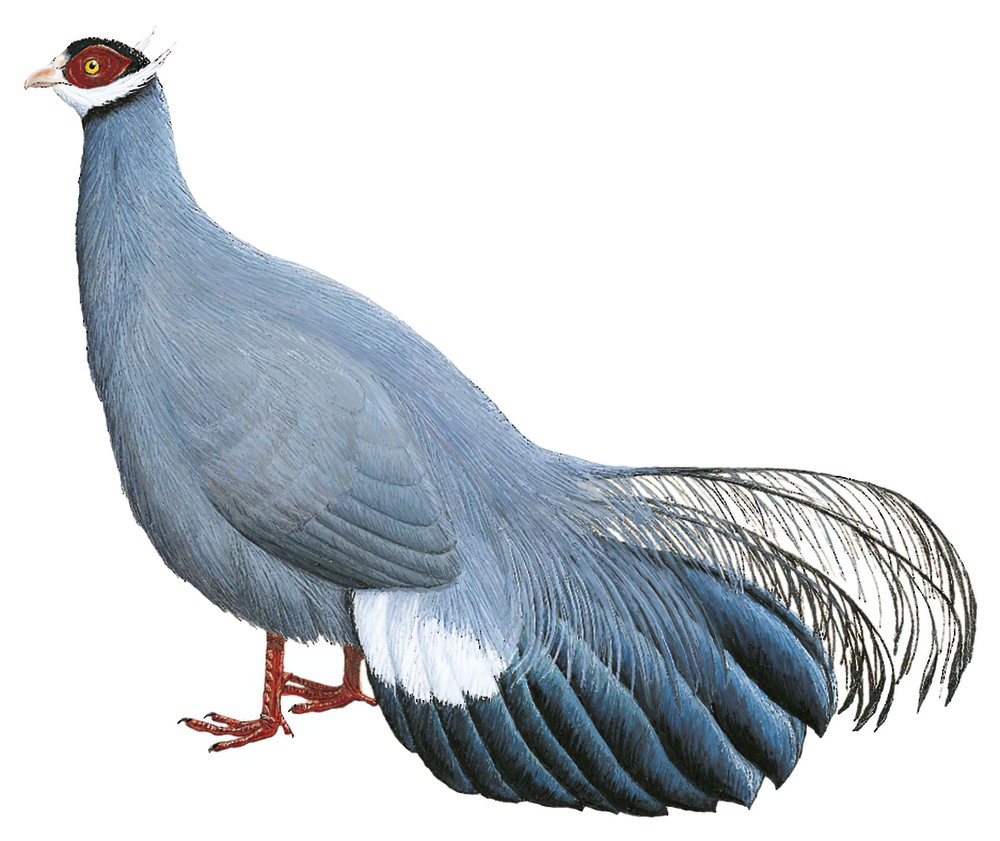Blue Eared-Pheasant / Crossoptilon auritum

Blue Eared-Pheasant
SCI Name:
Protonym: Phasianus auritus Zoogr.Rosso-Asiat. 2 p.86
Taxonomy: Galliformes / Phasianidae / Crossoptilon
Taxonomy Code: blephe1
Type Locality: Interior of China.
Author: Pallas
Publish Year: 1811
IUCN Status: Least Concern
DEFINITIONS
CROSSOPTILON
(Phasianidae; Ϯ White Eared Pheasant C. crossoptilon) Gr. κροσσοι krossoi tassels, fringe; πτιλον ptilon feather (cf. specific name Phasianus crossoptilon Hodgson, 1838 (see crossoptilon)); "Genus — new? Crossoptilon *, nob. Type Phasianus Crossoptilon, nob. Hab. Tibet. ... Like the true pheasant (Colchicus), our bird has no crest of any kind, though the feathers occupying the top of the head are of a peculiar kind, being short, velvety, thickset, erect, with their slightly discomposed and square points recurved a little to the front. ... * κροσσος a fringe; πτιλον a feather." (Hodgson 1838); "Crossoptilon Hodgson, Journ. As. Soc. Bengal, 7, 1838, p. 864. Type, by monotypy and tautonymy, Phasianus crossoptilon Hodgson." (Peters, 1934, II, p. 110).
Var. Crossoptilum.
crossoptilon
Gr. κροσσοι krossoi fringe; πτιλον ptilon feather. Hodgson 1838, wrote of the White Eared Pheasant, “It remains only to notice the plumage of the bird, which constitutes indeed its most remarkable feature. The plumage, then, upon the whole body is very ample, but not at all pointed, unglossed and wholly dishevilled, so as to remind one of the Struthious family. This peculiarity has suggested the name I have applied to the bird - a name which, for the present, may be considered specific, but liable to promotion to generic or subgeneric rank, if the form be proved to be typical, and not merely aberrant ... distinguished amongst all its congeners by its ample fringe-like plumage, the dishevilled quality of which is communicated even to the central tail feathers” (Crossoptilon).
auritum / auritus
L. auritus eared, long-eared < auris ear.
● ex “Mellisuga Cayennensis major” of Brisson 1760, “Oiseau-mouche à oreilles” of de Buffon 1770-1783, and “Violet-eared Humming-bird” of Latham 1782 (Heliothryx).
● ex “Sarcelle mâle de Madagascar” of d’Aubenton 1765-1781, pl. 770 (Nettapus).
● ex "Cormoran dilophe" of Vieillot 1825 (Phalacrocorax).
● "68. COLYMBUS. ... auritus. 3. C. pedibus lobatis, capite nigro, auribus cristato-ferrugineis. Fn. Svec. 123. Colymbus s. Podiceps minor. Aldr. orn. l. 19. c. 52. Will. orn. 258. t. 61. Sloan. jam. 2. p. 322. t. 271. f. 1. Raj. av. 125. Mars. danub. 82. t. 39. Alb. av. 2. p. 70. t. 76. Edw. av. 145. t. 145. & 96. l. 96. Habitat in summis Europæ & Americæ lacubus. Nidum natantem conficit." (Linnaeus 1758) (Podiceps).
● ex “Passarage Bustard” of Latham 1787 (syn. Sypheotides indicus).
UPPERCASE: current genus
Uppercase first letter: generic synonym
● and ● See: generic homonyms
lowercase: species and subspecies
●: early names, variants, mispellings
‡: extinct
†: type species
Gr.: ancient Greek
L.: Latin
<: derived from
syn: synonym of
/: separates historical and modern geographic names
ex: based on
TL: type locality
OD: original diagnosis (genus) or original description (species)












